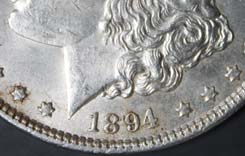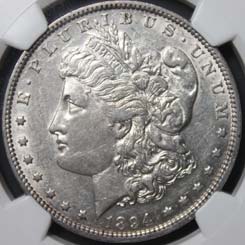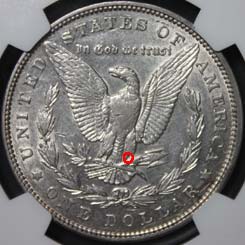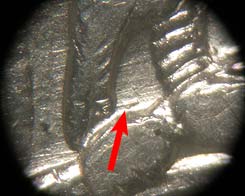Counterfeit Detection: How to Know Your 1894 Morgan Dollar Is Real
Posted on 9/20/2010
Recently, we’ve been getting heaps of fake 1894 Morgan Dollars. This is the standout Philadelphia Mint coin in the Morgan Dollar series, as only 110,000 were struck — only 10,000 more than the classic key of the series, the 1893-S. In actual fact, it’s a coin that looks, at least on paper, like it would be a lot rarer than it is, but it’s still a valuable coin in all grades. It has a NumisMedia value of $1,440.00 in XF grade.
The 1894-O is by no means a common date. 1.7 million were struck, but it’s much more common than its P-Mint counterpart and carries a NumisMedia value of $106.00 in XF. A frequently seen alteration is to remove the O mintmark from the reverse of this coin in attempt to pass it off as the rarer Philadelphia-issue that has no mintmark. First rule: always check the area above the DO in DOLLAR for a removed mintmark. Any scratches, discoloration or abrasion isolated to this area should be cause for concern.
 |
|
| Altered Date Morgan Dollar | |
A common alteration is also an altered date. The 1897 in particular is very common in circulated grades with a NumisMedia value of $21.28 in XF. Look at the last digit of the date to make sure it's spaced and shaped properly. An altered date example is illustrated. The 4 should be evenly spaced from the 9. Here it is clearly too close. Second rule: check the date for irregularities.
 |
 |
| Genuine 1894 Morgan Dollar. The red circle on reverse indicates the location of a key diagnostic. |
|
 |
|
| Die gouges on genuine 1894 $1. | |
But there are also die struck counterfeits, including newly made ones that are very deceptive. Fortunately, the genuine 1894 Morgan Dollar has a good diagnostic that can be seen under magnification. The red circle on the genuine example shows where to look. Die gouges that move from East to West can be seen in the space between the eagle’s left leg and tail feathers. A large gouge is visible just above the right-most talon of the eagle’s left leg, noted in the image by the arrow. Because this die line sits within a recess of the coin, it is visible on both low-grade and high-grade examples alike. If you’re looking at an 1894 dollar and this mark is not present, the coin is fake. Third rule: look for the die gouge.
Unfortunately, as counterfeiters advance their capabilities, collectors need to learn the diagnostics of genuine coins. This type of information requires years to commit to memory, but it’s important to understand this aspect of the science of authentication even if it’s difficult to put into practice. This coin illustrates well the value of die diagnostics to the professional authenticator.
To read other articles in NGC’s Counterfeit Detection series, see the full index on our website.
Stay Informed
Want news like this delivered to your inbox once a month? Subscribe to the free NGC eNewsletter today!
